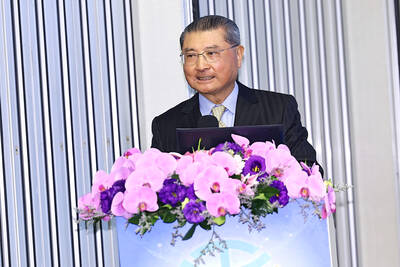Macronix International Co (旺宏), the world’s biggest supplier of NOR flash memory chips, yesterday reported a fifth consecutive quarterly loss for last quarter due to a weaker-than-expected pickup in customer demand.
Last quarter’s losses widened slightly to NT$296 million (US$9.22 million) from NT$286 million the previous quarter. On an annual basis, losses improved from NT$408 million.
“The third-quarter top line should have been better theoretically. It did not live up to our expectations. That is why our operating profit margin remained in negative territory,” Macronix chairman Miin Wu (吳敏求) told an online investors’ conference.

Photo: CNA
Operating profit margin improved to minus-4.6 percent last quarter from minus-7.9 percent the previous quarter, the best performance in five quarters.
“We had expected to turn a profit in the third quarter, but the overall business environment did not improve significantly and revenue fell short of our expectations,” Wu said.
Revenue expanded 20 percent sequentially, or 6 percent annually, to NT$7.76 billion last quarter.
Revenue from ROM products, primarily used in Japan’s Nintendo Co game consoles, dipped 20 percent annually last quarter, Macronix said.
“The demand from this customer in the third quarter was the weakest compared with the past third quarters, creating heavier pressure on us,” Wu said.
About 29 percent of Maronix’s revenue last quarter came from ROM products, down from 38 percent a year earlier, the company said.
NOR and NAND flash memory chips made up 55 percent and 8 percent of the company’s revenue last quarter respectively, while the remaining 8 percent came from foundry services, it added.
Gross margin last quarter fell to 28.9 percent from 30 percent in the second quarter, due to losses stemming from excessive inventory and lower utilization at its 8-inch fab, Wu said.
The average selling price remained steady, he added.
“We will work on more aggressive approaches to reduce inventory,” he said, adding that lowering factory utilization would not be an option.
Macronix gave a dismal outlook for the current quarter, but said it is positive about next year as it digests inventory.
“We would have a chance to grow next year,” Wu said.
The company said its customers are gradually depleting their inventories and ROM demand from Nintendo is expected to grow significantly with the launch of a new game console.
However, the world economy is forecast to improve tepidly next year, indicating soft demand, it added.
The company said it plans to issue NT$3 billion of corporate bonds and would use the proceeds to repay bank loans.

When an apartment comes up for rent in Germany’s big cities, hundreds of prospective tenants often queue down the street to view it, but the acute shortage of affordable housing is getting scant attention ahead of today’s snap general election. “Housing is one of the main problems for people, but nobody talks about it, nobody takes it seriously,” said Andreas Ibel, president of Build Europe, an association representing housing developers. Migration and the sluggish economy top the list of voters’ concerns, but analysts say housing policy fails to break through as returns on investment take time to register, making the

‘SILVER LINING’: Although the news caused TSMC to fall on the local market, an analyst said that as tariffs are not set to go into effect until April, there is still time for negotiations US President Donald Trump on Tuesday said that he would likely impose tariffs on semiconductor, automobile and pharmaceutical imports of about 25 percent, with an announcement coming as soon as April 2 in a move that would represent a dramatic widening of the US leader’s trade war. “I probably will tell you that on April 2, but it’ll be in the neighborhood of 25 percent,” Trump told reporters at his Mar-a-Lago club when asked about his plan for auto tariffs. Asked about similar levies on pharmaceutical drugs and semiconductors, the president said that “it’ll be 25 percent and higher, and it’ll

CHIP BOOM: Revenue for the semiconductor industry is set to reach US$1 trillion by 2032, opening up opportunities for the chip pacakging and testing company, it said ASE Technology Holding Co (日月光投控), the world’s largest provider of outsourced semiconductor assembly and test (OSAT) services, yesterday launched a new advanced manufacturing facility in Penang, Malaysia, aiming to meet growing demand for emerging technologies such as generative artificial intelligence (AI) applications. The US$300 million facility is a critical step in expanding ASE’s global footprint, offering an alternative for customers from the US, Europe, Japan, South Korea and China to assemble and test chips outside of Taiwan amid efforts to diversify supply chains. The plant, the company’s fifth in Malaysia, is part of a strategic expansion plan that would more than triple

Taiwanese artificial intelligence (AI) server makers are expected to make major investments in Texas in May after US President Donald Trump’s first 100 days in office and amid his rising tariff threats, Taiwan Electrical and Electronic Manufacturers’ Association (TEEMA, 台灣電子電機公會) chairman Richard Lee (李詩欽) said yesterday. The association led a delegation of seven AI server manufacturers to Washington, as well as the US states of California, Texas and New Mexico, to discuss land and tax issues, as Taiwanese firms speed up their production plans in the US with many of them seeing Texas as their top option for investment, Lee said. The